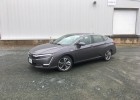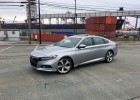
By Kevin Harrison
In 2007 the Honda Fit was introduced in our market and it was a pretty big deal. We Canadians love fuel efficient hatchbacks, but the Fit – known as the Jazz in other parts of the world – was a bit different.
Not only could die hard Honda fans finally get their hands on a small hatchback again (remember the Civic Si 5-door?) but it also meant that they could legitimately get rid of that mid-size CUV in the driveway.
You see the Fit is aptly named. Indeed it can fit a lot more stuff than its sub-compact dimensions would suggest and that’s thanks to the ‘magic’ seats which can fold and bend into several different combinations. This meant that large fern that you got on sale at Kent could be transferred back home no problem. It meant that you didn’t necessarily need to borrow a friend’s truck in order to purchase lumber. It meant you could easily transform it into a bed for those times when it was black Friday at the mall and you could nap in the parking lot rather than partake in the one time of the year where North Americans blatantly lose all respect for one another.
My sister bought one in the first model year and I’ve had the opportunity to drive it over the years. I remember thinking “this thing is easily best in class” with its aforementioned versatility, a small but peppy engine, good manual transmission and of course the added fuel efficiency, visibility and safety.
But then the Fit sort of fell off the map in its second generation. It adopted a controversial anteater-like profile and a bump in price while the likes of Ford’s Fiesta and the Mazda2 – while not nearly as versatile – were just as fun to drive (if not more) and had way more tech available; something not typically seen in the sub-compact segment. As a result, the Fit’s sales fell to the middle of the pack.
Hoping to address these issues, Honda took to the new third generation and promises its still king in the segment. I took one out to find out.
 Left to right: 2015 Honda Fit, 2007 Honda Fit
Left to right: 2015 Honda Fit, 2007 Honda Fit
Firstly, let’s start with styling, which is always a contentious issue in the sub-compact segment. You see, it’s rather difficult to make an attractive design as you don’t have much sheet metal to work with, but I think the designers at Honda did a pretty good job. Gone are the bug-eyed headlights in favour of a slanted look with a grille similar to that found on the Civic coupe. The side profile is no longer anteater-like and the rear is much more chiseled. Volvo may want to think about suing Honda for stealing their signature tail light design, but the look works well. Add in standard LED tail lights no matter which trim level you choose and rather aggressive looking optional 16 inch wheels and you’ve got yourself an eye-catching look.
My sister, Michelle, pointed out one thing she liked that was carried over from her generation and two things she didn’t like. She liked the fact that the tail-like antenna is still being used (as opposed to the shark-fin design on more premium vehicles) but was not a fan of the now red rear turn signals (which I whole heartedly agree with, check out my rant about it here) and the fact that Honda ditched the blue pearl dot on top of the ‘i’ on the Fit badging. You, on the other hand, may not be concerned about such things, but if you’re a hardcore Fit fan, this might ruin your entire day (I’m only half joking about that, Michelle was pretty upset about the lack of the blue pearl). That’s Michelle, the trunk monkey, and her trusty ’07 Fit next to the ’15 Fit in the pic below.
Another thing you might be upset to learn about – and for me, this could potentially be a complete deal breaker – is the lack of a volume knob on centre stack. Instead Honda has replaced it with the same nonsensical touch screen found in the new Civic. Apparently to adjust the volume you need to slide your finger up or down. While this may seem cool from a futuristic point of view, aesthetically and in practice, it’s quite stupid. It only responds to your commands properly half the time, and improperly or not at all the other half of the time. It’s something you never quite get used to and even though you can also use a more conventional button found on the steering wheel to adjust the volume, I’d wager most people are inclined to reach for the control found on the centre stack which is where its been for most of people’s lives. Still, having steering wheel mounted controls is a treat for most who are buying in the segment and Honda is looking to steal the ‘tech’ reputation from the Ford Fiesta by adding a camera underneath the passenger-side side mirror. Every time you signal right, it will show your blind spots, or if you prefer, you can push a button on the top of the signal stalk to have the camera stay on at all times. On top of that, the Fit gains a rear back-up camera, even though good rear visibility means it’s likely not needed, but is a good back up (excuse the pun).
On top of it all, I didn’t find the touch screen in general to be overly intuitive. Again, it only responds to touch commands when it feels like and the amount of steps it takes to find out that you didn’t spend enough to get sat radio.
There is the welcomed addition of a centre arm rest, but it is positioned way too low which would render it almost useless if it wasn’t for the fact that there is a deep cubby hole underneath it.
But it isn’t all bad, in fact those are really the only two foibles I can find with the interior. The design itself if nice with good fit and finish (again, excuse the pun) and the famous ‘magic’ seats are still in tact and still work brilliantly. Thanks to the Fit’s low hatch opening, loading and unloading heavy items is a breeze and you won’t have a hard time cramming in most of your stuff, even though the rear cargo area is slightly smaller than last year’s model. But the car’s wheels base has grown which allows for more interior leg room. This is one compact car that most would be able to sit comfortably no matter how tall they are. The only vehicle in the class that felt as if it had better head room was the Nissan Versa Note I tested last year.
The Honda Fit gets a bump in power for 2015 with a 1.5 litre 4-cylinder engine producing 130 horsepower and 114 pound foot torque. My tester came with Honda’s CVT (Continuously Variable Transmission) and it is soul sucking to the core. Seriously, do yourself a favour and go with the manual transmission. Not only will you get a slick shifting gear knob as per Honda’s reputation for making them, but you’ll be more in control of the car and, crucially, you’ll be able to get the most out of the engine, maintaining the Fit’s peppy, fun to drive fame. The CVT is loud, which takes away from Honda’s “quiet interiors” reputation, and it neuters power.
Happily, the Fit will still handle like a star even if you do foolishly decide to waste 1,500 of your hard earned dollars on that CVT. While steering could be a bit more direct, you’ll have no trouble tossing it into a corner. Honda pushed the wheels out to the corners, giving it a solid, planted, almost go kart-like feel. This makes driving around the city a blast. On the highway, the Fit feels solid, with little wind noise. The only noise you’ll hear is the droan of the CVT: “do we HAVE to go 100 km/h?”
You may be wondering at this point why the CVT is even implemented if it’s the collective bane of automotive journalists everywhere. Well, manufacturers use it because the transmission is inherently efficient. Despite feeling like one big long gear, Honda has introduced fake gears with paddle shifters if you want the sensation of a regular gearbox. But back to the transmission being efficient, the Fit is rated at 7.3 L/100 kms city and 6.1 L/100 kms highway. My real world combined driving resulted in an impressive 6.3 L/100 kms. So, if fuel efficiency is more important to you than a fun to drive car, then perhaps the CVT is for you. But the Fit’s efficiency isn’t solely thanks to the CVT, it actually has an Econ button in green which, when pushed, will keep your RPM’s (revolutions per minute) low, saving you fuel. On top of that, Honda has used lighter weight materials which was particularly noticeable in the doors. They are extremely light, to the point where I can count on both hands the amount of times I, or my passengers attempted to close the door only to have to do it again because the doors were so light.
But seriously, this new Fit, despite the CVT (which you don’t have to go with) and the silly touchscreen is definitely still my pic in the segment. It looks better, it drives better, has more power, good efficiency, and, crucially, a lot of room for your stuff. It is likely the ultimate non-hybrid city car. Yes, I said it, Smart Fortwo.
Price As Tested: $20,495
Pros:
- Nicer, more corporate design
- Oh Oh, it’s magic! Seat configuration
- Tons of room for people and cargo
- Good on gas
- Good handling
- Blind spot and back-up cameras
Cons:
- Give me back my volume knob!
- Ideally, a touch screen works 100% of the time, not 50%
- CVT will numb your brain
- Centre arm rest too low
Immediate Competition:
- Chevrolet Sonic 5-door
- Ford Fiesta 5-door
- Hyundai Accent 5-door
- Kia Rio 5-door
- Mazda2
- Mitsubishi Mirage
- Nissan Versa Note
- Toyota Yaris













